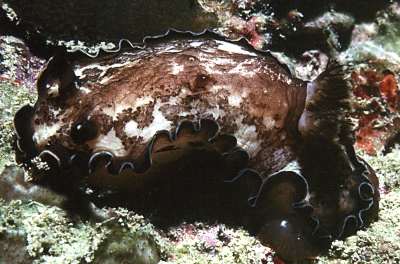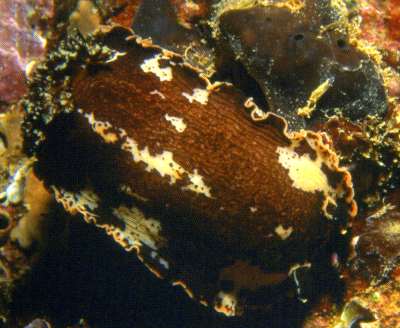

Aphelodoris gigas
Wilson, 2003
Order: NUDIBRANCHIA
Suborder: DORIDINA
Superfamily: EUDORIDOIDEA
Family: Dorididae
DISTRIBUTION
At present known only from North Western Australia
PHOTO
Upper: Long Reef, Kimberley, Western Australia, preserved length 43 mm.WAM S24940. Photo: C. Bryce. Lower: Legendre Island, Dampier Archipelago, Western Australia, 12 m on sponge, Penares sp., 30 July 2000, preserved length 53 mm, WAM S12652. Photo: N. Wilson.
-
Wilson, N. G. (2003). Australian Aphelodoris (Mollusca: Nudibranchia): two new species, sperm ultrastructure and a redescription of Aphelodoris greeni Burn. In: F. E. Wells and D. I. Walker (eds), The Marine Flora and Fauna of Dampier, Western Australia. Western Australian Museum, Perth. Volume 2: 563-587
Rudman, W.B., 2006 (February 7) Aphelodoris gigas Wilson, 2003. [In] Sea Slug Forum. Australian Museum, Sydney. Available from http://www.seaslugforum.net/find/aphegiga
Related messages
Re: Aphelodoris gigas from Komodo
April 23, 2008
From: Philip Cromwell

Concerning message #20833:
Hi Bill,
I think I can see the rhinophore of a second A. gigas behind the behind the green and yellow fronds of the feather-star, in the last picture. What do you think?
Phil
aegir429@yahoo.com
Cromwell, P. A., 2008 (Apr 23) Re: Aphelodoris gigas from Komodo. [Message in] Sea Slug Forum. Australian Museum, Sydney. Available from http://www.seaslugforum.net/find/21539Well spotted Phil,
Yes there is another specimen under the crinoid. I've cropped a close-up from the original file.
Best wishes,
Bill Rudman
Aphelodoris gigas from Komodo
April 22, 2008
From: Natasja Vandeperre


Hello Bill,
As you don't have that many records of Aphelodoris gigas yet, here are some photos taken at Komodo, Indonesia.
Locality: Komodo, Indonesia, May 2007. Photographer: Karen Verwulgen
Greetings,
Natasja
postmaster@naaktslakken.be
Vandeperre, N., 2008 (Apr 22) Aphelodoris gigas from Komodo. [Message in] Sea Slug Forum. Australian Museum, Sydney. Available from http://www.seaslugforum.net/find/20833
Thanks Natasja,
Most species of Aphelodoris are from temperate waters so it is good to get another record of this unusual tropical species.
Best wishes,
Bill Rudman
Aphelodoris gigas (?) from Palawan, Philippines
May 15, 2007
From: Michael Jimenez

Hi Bill,
Not sure if this is a Dendrodoris nigra ... can you help ID?
Locality: Club Noah Isabelle, Depth: 50 ft, Palawan, Philippines. Sulu Sea
Length: 4 inches. 31 March 2005. Reef and sand junction. Photographer: Michael Jimenez
Mike
mpj17@pacbell.net
Mike Jimenez, 2007 (May 15) Aphelodoris gigas (?) from Palawan, Philippines. [Message in] Sea Slug Forum. Australian Museum, Sydney. Available from http://www.seaslugforum.net/find/13558Dear Mike,
This seems to be a species of Aphelodoris, and is possibly a newly named species from Western Australia, Aphelodoris gigas. However Nerida Wilson in a recent message [#19834] felt there were probably quite a few species to be named in the 'region' but we will have to wait until someone has the courage - and sufficient specimens - to study them
Best wishes,
Bill Rudman
Re: Aphelodoris gigas? from Western Australia
April 24, 2007
From: Bruce Potter

Concerning message #19834:
Dear Bill,
In response to Nerida Wilson's message, I have included a front on photo of the Nudibranch in question. [Photographer: Bruce Potter]
I hope it helps
Regards
Bruce Potter
bandppotter@bigpond.com
Potter, B., 2007 (Apr 24) Re: Aphelodoris gigas? from Western Australia. [Message in] Sea Slug Forum. Australian Museum, Sydney. Available from http://www.seaslugforum.net/find/19837
Thanks Bruce,
There doesn't seem to be a pigmented white line down the midline of the rhinophores, but there is an unpigmented strip. I guess that is a 'not proven' but at least it clarifies a colour detail of your animal
Best wishes,
Bill Rudman
Re: Aphelodoris gigas? from Western Australia
April 20, 2007
From: Nerida Wilson
Concerning message #19599:
Dear Bill and Bruce,
I would say its unlikely that this animal is Aphelodoris gigas. One of the features of A. gigas is that it has a white line in the centre of the rhinophores (anteriorly and posteriorly), and this appears to be lacking on this animal. There are also many other undescribed Aphelodoris species in this region. However, aphelodorids are characterized by variation in colouration, and definitely need more work!
kind regards
Nerida
ngwilson@ucsd.edu
Wilson, N.G., 2007 (Apr 20) Re: Aphelodoris gigas? from Western Australia. [Message in] Sea Slug Forum. Australian Museum, Sydney. Available from http://www.seaslugforum.net/find/19834Thanks Nerida,
I hope the tentative nature of my identification was obvious. I am a bit frightened by your suggestion of 'many other undescribed Aphelodoris species' in the region. The existing ones in southern Australia are already quite a struggle to separate from each other - the addition of another group along the Western Australian coast might be too much for me.
In the case of Bruce's animal, hopefully he may have a photo which shows the rhinophores more clearly
Best wishes,
Bill Rudman
Aphelodoris gigas? from Western Australia
April 19, 2007
From: Bruce Potter

Dear Bill,
I recently did a dive on a small jetty in Rockingham, just south of Perth WA. I found quite a variety of Nudibranchs there, and will send you a few of them.
I have not been able to identify this one. It appears to be an Aphelodoris, but I cannot find one with this orange boarder around it. There were several of them around, and all like this. It was about 35mm long. The site is under a small jetty and quite mucky at about 6 metres.
Locality: Rockingham, 6 metres, Western Australia, Indian Ocean, 24 February 2007, Mucky under Jetty. Length: 35 mm. Photographer: Bruce Potter.
Regards
Bruce Potter.
bandppotter@bigpond.com


Dear Bruce,
It ceratinly looks like an Aphelodoris and one possibility is that it is a juvenile of a recently described species from Western Australia, Aphelodoris gigas. I have include close-ups of the head and gill region to show the orange border to the foot, mantle and rhinophore pockets so it can be compared with more typical A. gigas. My understanding is that in A. gigas, the orange mantle border, if present is submarginal
Best wishes,
Bill Rudman
Re: Aphelodoris gigas from Indonesia
December 19, 2006
From: Roberto Sozzani

Concerning message #19017:
Dear Bill,
Is this one also an Aphelodoris gigas? I've seen this species several times, often in couples, on corals, rubble and black sand in Sumbawa, Komodo and Rinja, but I was never able to give him a name.
Locality: Rinja island, 8 metres, Indonesia, Pacific Ocean, June 2003, coral and rubble slope. Length: 8 cm. Photographer: Roberto Sozzani.
Best wishes
Roberto Sozzani
www.robertosozzani.it
roberto.sozzani@fastwebnet.it


Dear Roberto,
Certainly from the raised rhinophore and gill pockets this could be a species of Aphelodoris, so this could well be A. gigas. The anatomy of these Indonesian animals would need to be checked to be sure but its genera shape and colour are consistent with the little we know about A. gigas.
Best wishes,
Bill Rudman
Aphelodoris gigas from Indonesia
December 15, 2006
From: Teresa Zuberbühler


Dear Bill Rudman
I think this might be a species similar to Aphelodoris sp 1 from Australia but with more drab colors and no orange margin.
I have found this nudibranch in several places in Indonesia, mainly in Nusa Tenggara (Komodo, Lombok, Flores) and would like to know which species it is. I have seen it mainly on rubble, where it is difficult to see because of its brown color. I send you 2 photos with different color variations and a photo where the front and the foot of the slug can be seen well, this might help you for the identification.
Locality: Komodo, 15-20, Indonesia, Indopacific, rubble areas close to coral reef. Length: ca. 8 cm. Upper photo: 22 July 2004; Middle photo: 29 July 2003; Lower photo: 6. August 2003. Photographer: Teresa (Zubi) Zuberbühler.
Thanks for your help
Teresa (Zubi)
www.starfish.ch
webmaster@starfish.ch
Zuberbühler, T., 2006 (Dec 15) Aphelodoris gigas from Indonesia. [Message in] Sea Slug Forum. Australian Museum, Sydney. Available from http://www.seaslugforum.net/find/19017
Dear Zubi,
This is a nice find. It is indeed the animal which was on the Forum as Aphelodoris sp. 1. That species has since been named Aphelodoris gigas. (I should have noted this on the Aphelodoris sp. 1 Fact Sheet). As you will see on the A. gigas Fact Sheet, the orange mantle border can be absent. Until now this recently described species has only been known from NW Australia, so it is good to get a record from Indonesia.
Best wishes,
Bill Rudman
More species of Aphelodoris
February 11, 2006
From: Bill Rudman
I have just added Fact Sheets for two more species of Aphelodoris from Western Australia.
Aphelodoris gigas Wilson, 2003
Aphelodoris karpa Wilson, 2003
- Wilson, N. G. (2003). Australian Aphelodoris (Mollusca: Nudibranchia): two new species, sperm ultrastructure and a redescription of Aphelodoris greeni Burn. In: F. E. Wells and D. I. Walker (eds), The Marine Flora and Fauna of Dampier, Western Australia. Western Australian Museum, Perth. Volume 2: 563-587
Best wishes
Bill Rudman
Aphelodoris from NW Australia
May 11, 1999
From: Clay Bryce

Note added 14 December 2006: This has been described as Aphelodoris gigas.
Dear Bill,
Here is another species, perhaps a new record?, from the Dampier Archipelago in the Kimberley region, Northwestern Australia.
WAM12043: A large Aphelodoris. Seem to occure from Dampier and right through the inshore Kimberley. There appears to be quite a bit of dorsal colour variation but the orange margin to he mantle and foot are constant.
Clay Bryce,
W.A. Museum
Perth.
brycec@museum.wa.gov.au
Bryce, C., 1999 (May 11) Aphelodoris from NW Australia. [Message in] Sea Slug Forum. Australian Museum, Sydney. Available from http://www.seaslugforum.net/find/835Dear Clay,
I have seen a number of photos of this over the years and it seems to be restricted to Western Australia. It is probably a distinct species but there are not many useful anatomical characters to use in the genus.
Bill Rudman.
